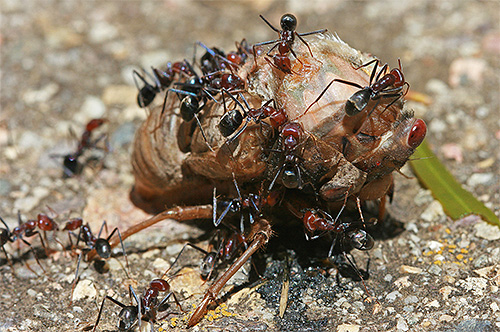
Ants are famous for their omnivorous. And not even so much forest and field ants, which can be found busily in a anthill carrying a dried leaf, a dead fly or bread crumb. Their versatility in nutrition is especially different. pharaoh ants - common household pests. They can find abundant food sources even in a perfectly clean apartment. Sometimes it seems that these ants eat everything: a drop of oil that fell on the floor behind the tile, crumbs near the plinth, sugar scooped off the table - and on this issue, the whole anthill safely grows and develops.

But scientists, who studied in detail what the ants eat, found that, after all, these insects cannot be called illegible swallowing. In the choice of food, they are very similar to humans: even though their diet can include thousands of products, they eat according to a strict system.And besides, among the ants there are such gourmets, which are suitable for food only one, very rare and exotic product.
Standard diet of the most common species of ants
Food for ants of most species is a wide range of simple products of both animal and vegetable origin. Pharaoh ants, and in the tropics - other species that live in residential buildings, actively and with pleasure eat synthetic food products used for preparing semi-finished products or as seasonings.
It is noteworthy that the ants are dragging into the anthill all the products that they come across, after which the whole food ration is divided in a certain order between the colony members:
- the larvae eat mostly protein foods of animal origin. In nature, these are the remains of other insects or larger animals, eggs of various pests, and in the house or apartment, in addition, dairy products, gelatin, and remnants of egg dishes. Protein food is essential for the larvae - they need to grow and develop.
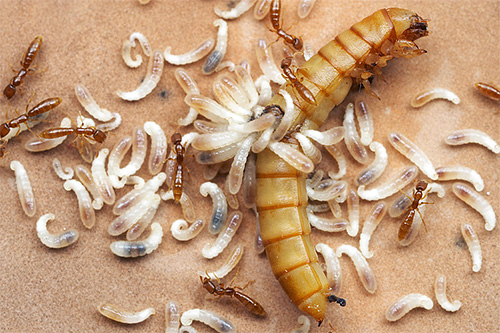
- Adult ants feed mainly carbohydrate-digestible food - fruit pulp, seeds, nuts, rhizomes of plants, tree sap, padya,and in residential areas - honey, sugar, jam.
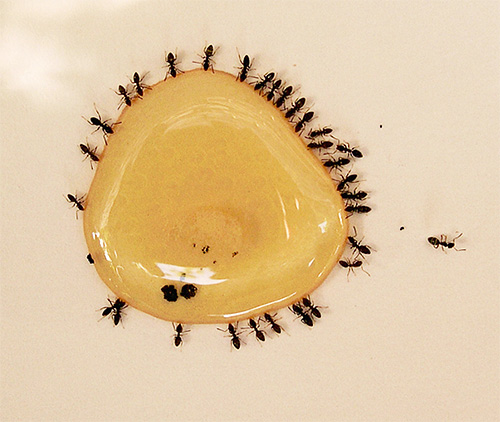
It is difficult for ants to isolate some product prevailing in the diet. If only because each species occupies its own ecological niche and specializes in extracting certain feeds.
On a note
Some ants are obligate predators. For example, stray ants or the cerapahis feed almost exclusively on insects at all stages of their development.
The uterus also eats mainly protein foods, and in many species caring for uterus ants chew food for her and provide the most convenient "dessert" for her.
The basis of the carbohydrate diet in many species of ants are honeydew and pad. The first is the sweet juices secreted by the leaves of the trees with sharp fluctuations in temperature. The second is the sugary excretions of some insects, among which the most known aphid.
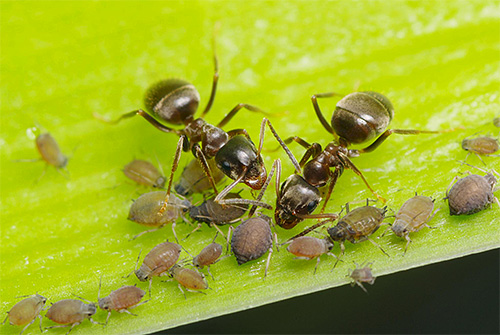
It is interesting
According to scientists, in ordinary red forest ants, the fall makes up about 60% of the diet! It is not surprising that these forest workers are so attached to the herds of their milk aphids.
And the wood ants as a source of carbohydrates collect gums - the well-known wood resin released in places of damage to the bark of the tree.However, they are also very tied to the colonies of aphids - all ants should be eaten frequently, and the gum is released on the bark non-permanently.
In reaper ants, the basis of the carbohydrate diet is dry grass seed - a rather coarse and solid food. The soldiers' work of these ants in their free time from the defense of the nest is grinding the powerful jaws of such seeds to produce a kind of soft gruel, which other members of the colony can feed on.
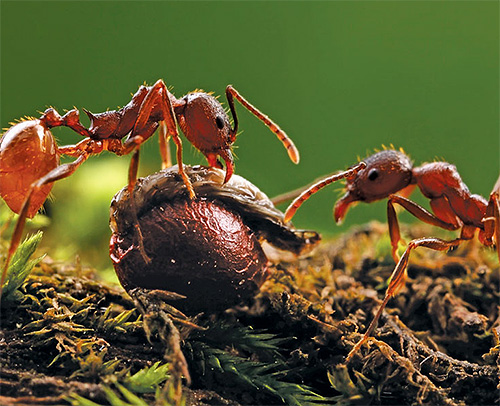
How often do ants eat?
Ants eat frequently - several times a day. As a rule, forager ants (those whose task is to find and transport food) combine the pleasant with the useful, feeding on a part of the feed assigned to the ant hill. Ants in the anthill are constantly fed from the collected stocks.
It is interesting
In many anthills live insects that have adapted to the neighborhood of ants - some beetles and their larvae, some species of moths. Usually they protect themselves with the ability to secrete the pad, thanks to which the ants not only do not offend them, but also allow them to feed on their own eggs. Each ant, running past such a tenant, will not miss the opportunity to tickle the beetle or the caterpillar with antennae and get a portion of sweet syrup in return.
Ants can go on hungering for a long time only during the wintering period, and then only during wintering during supercooling. Most domestic ants hibernating under the ground do not fall into hibernation, and in winter they continue to stay awake in the clogged anthill. For food in this period they use previously collected abundant reserves.
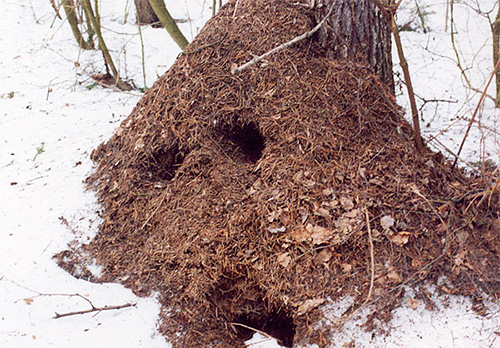
It is interesting
In the southern regions of our country, reaper ants can gather up to a kilogram of seeds in an anthill for a warm period of the year - this is enough for a normal colony in the winter. During wintering time, the larvae do not have an anthill, and the colony does not need protein food. By the way, seeds make up about 97% of the diet of the ants reapers.
During the winter, ants can go hungry, especially when the temperature drops. Ants living in the northern part of Russia can stay in a state of hibernation for up to 9 months a year without eating anything.
On a note
Fans to keep ant colonies at home know that the main rule of successful ant breeding is the constant availability of food in insect free access. Even when wintering, when an artificial anthill is placed in a refrigerator,Food is constantly being placed in the feeder: at temperatures above zero, some foragers can run out of the nest in search of food.
The type of food that is important for all ants is the so-called trophic eggs - eggs laid by the uterus during the period of excess food and not developing into larvae. Their ants eat with the deficiencies of other feed in the "hungry" months.
Ants gourmets, or examples of narrow food specialization
Among ants, there are a large number of species that prefer to use only one or two products instead of a wide variety of feeds. Among these species are the following:
- Leaf cutter ants are one of the few living beings in general who have learned how to farm. They collect pieces of leaves in the anthill, bitten by foragers, chew these leaves into a mushy mass, put in special chambers in the nest, act as greenhouses, and feed on the mushrooms developing in the leaf mass. At the same time, the leaves themselves are not suitable for food by ants, because they are too rough and poorly nourished.
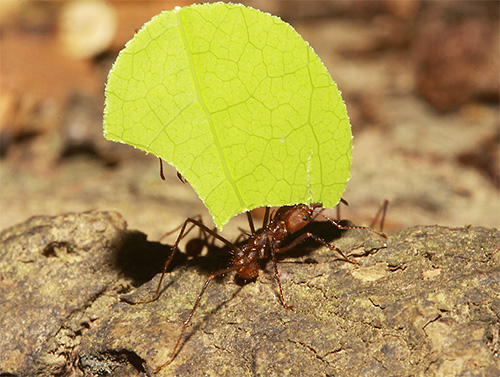
- Ants-centrmirxes, which eat exclusively termites.
- Ponerins are the subfamily of ants, each species of which specializes in feeding on one type of insect.
- Dracula Ant is a unique species with a very narrow food specialization. Its adults feed exclusively on the juices of their own larvae. And the larvae themselves, in turn, do not suffer from this at all. At the same time, adult ants catch various insects, centipedes and spiders, but they do not eat them themselves, but feed them on a growing shift.
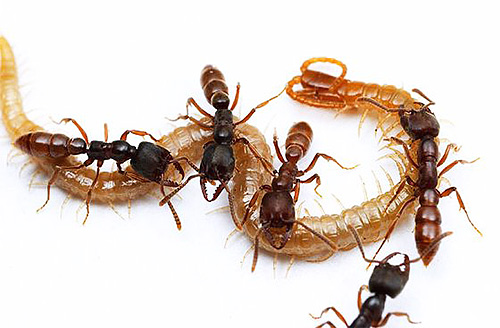
At the same time, the feeding of the larvae of ants is so specific that it is necessary to tell about it separately.
What feed ant larvae
According to the method of feeding, the larvae of different species of ants are divided into two types:
- self-powered
- and not able to eat themselves.
The latter are more numerous. Adult ants feed them with the trofollaxis method, that is, transferring semi-digested food to the larva from their esophagus.
The larvae, which are able to feed themselves, eat dead insects brought to the anthill or other protein food, sometimes trophic eggs and even larvae from other anthills. But only leaf cutter ants feed their younger generation of grown mushrooms.

On a note
Due to the fact that in winter, ants of middle latitudes do not have access to protein food, for one year in temperate climates they usually give one generation, and only adult ants able to feed on plant stocks will spend the winter. In the same ants that hibernate, hibernating, the larvae can also hibernate - they do not need forage in a state of anabiosis.
From what kind of food the larva receives, it will depend on whether it turns into a working ant or a womb capable of reproduction after pupation. In this way, the anthill is similar to a real democratic society: the working ants in it decide how many workers there will be in each colony, and how many will keep the clan.
Interesting video: how ants eat sausage (shooting accelerated 700 times)

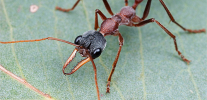


Is it true that forest ants eat garden ants?
Not.
Not
How far do ants go for food?
It depends on what kind of food they want. Depending on this, they can go far.
What ants eat in the winter?
In winter, they hibernate.
No, they do not hibernate. Most domestic ants hibernating under the ground do not fall into hibernation, and in winter they continue to stay awake in the clogged anthill. For food in this period they use previously collected abundant reserves!
You all wrote in detail that is not clear?
She has ants in her head.
Ants feed on May beetles.
Ants feed on larvae and stocks.
Sugar probably
Are you crazy?
Yes, in my area, the ants caught the May beetle, dragged it into their nest.
They are so cruel, they generally eat beetles, tearing them away from a still live insect.
They feed on the flesh.
Yes, it's right
If you store in the box 2 ants and 9-10 cm of bread, then they can live there for 7 years.
Without a queen, ants are likely to die in 3-4 weeks, which is their natural period of life.
You are mistaken, most of all types of working ants live from 2 to 5 years.
They are omnivores.
Do not buy ants.
Why? Anyway, you can not destroy their homes.
Is the light harmful to ants? Not solar, but for example, from a lamp or another source.
If they are in a test tube, then the sunlight will not harm them, and electric lamps should be kept away.
Well, that ants and mosquitoes devour.
If you have 8 ants and all workers in an anthill, how will the queen appear?
Let the guys work.
They love Khrushchev larvae.
My daughter Elya has been growing ants since she was five years old. We bought a large aquarium, put there the land and all sorts of different foods, and caught some ants. We were looking forward to the first children and even sometimes took birth) We saw the ants extract their cubs from the testicles. At first the children were light, and then they began to get dark. We have been growing ants for almost ten years.
Do they eat worms and flies?
Great!
They eat chocolate balls ...
Horror! How do you not disdain? We moved with our two children to a new apartment, but it turns out that the ants in the bathroom are so small and red. So I do not allow children to go into the bath and especially, but I keep towels in the bedroom. She sprinkled with dichlorvos, so they, along the way, gathered in the other rooms to get along. How to get rid of them? I heard that they bite (((
At home, I made a terrarium and keep ants there. I feed them meat, honey sauce, still put a water bowl with water. They live with me for about a month. It is very interesting to watch and care for them.
1) Ants without a uterus will live or not?
2) And how to find the uterus?
Without the uterus, the ants will gradually die, and in order to find the uterus it is necessary to unearth an anthill.
1. Without a uterus they can live not for long, less than a month.
2. Try when you collect ants, and find the uterus.